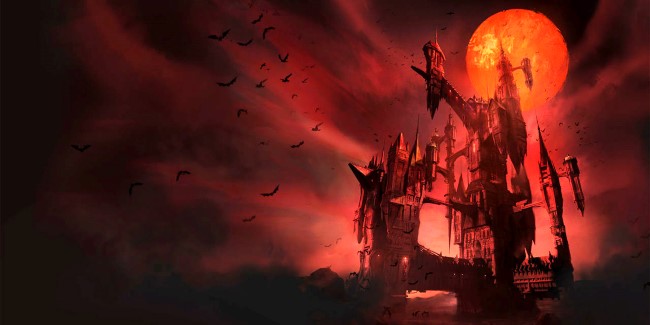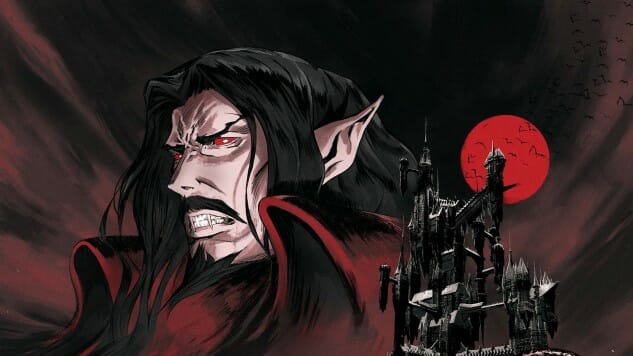When Netflix’s Castlevania first appeared on the service in the summer of 2017, sporting only four episodes in its first “season,” reactions from impassioned fans of the classic Konami franchise typically fell into two camps.
First, there was abject excitement about the mere existence of a project that so stylishly and sumptuously transplanted the DNA of the Castlevania videogames into the format of a western-style anime. It was immediately clear that this adaptation would, at the very least, look and feel like the classic gothic Castlevania of old—a world of towering castles, winged monsters, perpetual night and relentlessly catchy church organ melodies.
But there was also some level of consternation in those early reactions about the relative lack of payoff in what was essentially a feature-length proof of concept. In the four episodes fans were initially given, there was really only time to lay a framework, albeit one that would later pay dividends. We were given the foundational basis on all the characters—surly Trevor Belmont, idealistic Sypha Belnades, brooding and noble Alucard—and their blighted world, only to have things end right when they were starting to get interesting. Then came the long wait, and the anticipation of the coming darkness born of Dracula’s righteous crusade against humanity after the death of his wife.
Well, after having time to digest the Halloween arrival of Castlevania’s season 2, there’s really only one thing to say: This is the best pure videogame adaptation we’ve witnessed to date. By just about any metric, season 2 of Castlevania exceeds any feature film attempt to adapt a game’s source material.
As in its first season, the place of most obvious and immediate success is in the visuals, music and overall aesthetic of this show. Its settings, whether they’re medieval towns, ruined churches, clockwork dungeons or Dracula’s labyrinthine skyscraper of a castle, all feel ripped from beloved early entries in the Castlevania series, from the NES original and through its sequels, Simon’s Quest and Dracula’s Curse. There’s bits and pieces of the SNES Super Castlevania IV here, and more than a little of the beloved Symphony of the Night, particularly in the character design of Alucard and Dracula himself. Passionate fans of the series have no shortage of Easter eggs to spot, particularly in the meticulously crafted relics present in the Belmont estate, all of which seem to be modeled after items and power-ups from various entries in the series.
 Just try to tell us that this image isn’t “Peak Castlevania.”
Just try to tell us that this image isn’t “Peak Castlevania.”
But it’s not slavish devotion to geeky videogame ephemera that makes Castlevania such a wonderful adaptation—it’s the show’s surprisingly dedicated and patient focus on character, which intuitively extrapolates and invents pathos and emotional ties at every step along the way. These are largely characters, after all, who had their birth in NES titles without much plot, dialog or development to speak of. In order to support multiple seasons of a series, there was always going to need to be a greatly expanded mythos, and motivations for someone like Trevor Belmont beyond “he’s from a family that hunts vampires.” That’s where Netflix’s show is such a beautiful success, in the welding of artistic license and dramatic pathos to gleeful fan service.
With that said, it does take a little while before season 2’s success becomes abundantly clear. I would not begrudge an audience member who said they drifted away and stopped watching after the first few episodes of this season, because those episodes made only occasional dalliances into what you might describe as “action.” Instead, the first half (the first five episodes, really) of season 2 is devoted almost entirely to rumination on characters and the deepening of each major player’s individual resolve, while introducing others into a wider power struggle. Most notable is the amount of time we spend with Dracula, an increasingly tragic figure who seems to be a shell of his former self. The last thing you’d expect from a Castlevania adaptation might be to say that it spends half a season focused on a portrait of hollow grief and self-destructive ennui, but that’s the reality of what happens. It’s easy to see how some viewers might label these quiet moments as “boring”—or find individual characters like the viking vampire Godbrand to be annoying or tonally disruptive—but they’re ultimately proven integral to the season’s final three episodes. The season intentionally backloads its payoffs, to make them all that much grander when they arrive.
Oh, and what a payoff it truly is. Let us lay out the challenge: Find us a more deeply satisfying interpretation of actual “gameplay” on screen than the 27 minutes that comprise this season’s seventh episode, “For Love.” Armed with every thread of mythology and pathos that Castlevania establishes in the first half of the season, from the Belmont clan’s Morningstar whip to the psychic wounds suffered by Alucard at the hands of his father, the show delivers an instantly iconic battle scene and picks exactly the right moment to accompany it with “Bloody Tears.” The result is nothing short of spectacular—more than four straight minutes of explosive, beautifully animated combat glorifying everything a fan could possibly love about the Castlevania brand, while giving each character ample opportunity to shine. I honestly don’t see any way this could be improved, and I’ve watched it about a dozen times.
And that’s just the appetizer for the ultimate confrontation with Dracula under the blood-red moon. Suffice to say, both the action and the dramatic catharsis of the Alucard/Dracula confrontation work beautifully, mirroring the catharsis experienced by the audience when it is suddenly inundated with so much fan service after numerous dialog-heavy episodes. The action is all the sweeter for the sense that it has been well earned, like the blow-off to a years-long pro wrestling feud. In fact, good wrestling booking might be the best parallel to how well the big conclusion of “For Love” is scripted—it makes our heroes look capable and valiant, while still preserving the menace and overwhelming power of Dracula. Should he ever return or be resurrected, our protagonists should be properly terrified.
And of course, this being Castlevania, that scenario is entirely possible. But season 2, among its many other positive attributes, is notable for just how many potentially interesting threads it established to follow in the already ordered 10-episode season 3. With Dracula dead, at least for now, we’re free to follow storylines weaving around all the remaining players who will now step up to major roles: Carmilla and the captive Hector; newly motivated necromancer Isaac; adventuring Trevor and Sypha, and more we haven’t yet encountered. If the surprisingly thoughtful treatment of Hector and Isaac in season 2 is any indication, Castlevania is by no means content to simply stick to the best known “player characters” from the games as its focus, and will instead continue to feature viewpoint characters drawn from the depths of franchise lore. It’s an encouraging thought, even if it’s difficult to imagine how season 3 could possibly match the poignant zenith we were gifted in season 2.
Still, when you’ve just created a new claimant to the title of “best videogame adaptation of all time,” you’ve probably earned a little bit of faith, right?

 Just try to tell us that this image isn’t “Peak Castlevania.”
Just try to tell us that this image isn’t “Peak Castlevania.”